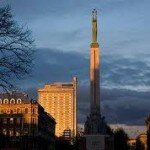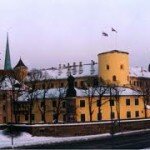Art Nouveau in the Architecture of Riga
Alberta iela,
Elizabetes iela,
Vilandes iela,
Strelnieku iela
Art Nouveau is one of the styles that dominates Riga`s architectural heritage. Spread throughout the city, but you will find the most expressive specimens concentrated on the above mentioned streets. Most of these buildings are constructed by the architect M. Eisenstein.
Freedom Monument
Brivibas iela

The Freedom Monument in Riga at dusk
The monument was designed by the famous Latvian architect Karlis Zale and constructed in 1935. The bronze casting of a woman (fondly nick-named “Milda” by the Latvian folk) holds up three golden stars in her hands. The stars symbolise three Latvian regions: Latgale, Kurzeme and Vidzeme. The guard of honour stands sentinel at the monument from 09.00 until 20.00, the hourly change of guard is very impressive!
Three Brothers
17, 19, 21 Maza Pils iela
The “Three Brothers” are the best examples of residential buildings of medieval Riga. The “eldest brother” (No.17) was built in the 15th century and is the oldest stone dwelling-structure in Riga.
Riga Castle
3 Pils laukums

Riga Castle in the Snow
The first castle built by the Order of the Sword Brothers around 1209 and originally named Wittenstein Castle (“made of white stone”). The castle was destroyed by townsfolk in the civil war. Townspeople built a new castle for the Livonian Order at the site of the Holy Spirit hospital under the condition of dismantling part of the town’s fortification wall and opening the townfrom the castle side. The tower of the Holy Spirit and a fragment of the fortification wall were added to the castle that was built under the supervision of Master D.Kriege in 1330–1353. In 1484 the citizens destroyed this building as well, but this time they were forced to rebuild it and the reconstruction was completed by 1515. In the 16th and 17th centuries the castle was incorporated into the town’s fortification system. In the 18th cent. several wings were added and the castle was used as a public building by Polish and Swedish officials, the moat surrounding the castle was filled up and the square near the castle was constructed. In the 18th century it became a residence for Russian Governor General. Nowadays the castle is the President’s residence.
Powder Tower
20 Smilsu iela
First mentioned in 1330, used to be called the Sand tower because it defended the city from the side of the Big Sand Road. The tower received its present name in the 17th century when it was used to store gunpowder and cannonballs. The latter are still stored in the outside walls of the tower!
Dome Cathedral
Doma laukums
The largest cathedral in the Baltics was founded by Latvia`s Teutonic conquerors in the beginning of the 13th century under the bishop Albert. This well-known historical church has become an icon of the Old Town of Riga. In the past centuries it has been destroyed and rebuilt many times, so presently it is a composite of different architectural styles. The cathedral`s last reconstruction took place in 1776 the tower was raised to the height of 90m. The famous organ of the Dome cathedral was made in 1884, it was the biggest organ in the world comprised of 6 718 pipes!
St. Peter’s Church
19 Skarnu iela
First mention of St. Peter’s church was made in the year 1209. The church is one of the best examples of Gothic architecture in the Baltics, meant to be the main church of the town. The church tower seemed to be jinxed, it was burned down and rebuilt many times trough the centuries. It first collapsed in 1666 and the last destruction it suffered was on St. Peter’s Day in 1941. In 1973 the tower was restored for the last time. From the observation platform of the tower you can enjoy a wonderful eagle’s-eye view of Riga.
House of Blackheads
Ratslaukums
First mentioned in 1334, the building was owned by the Great Guild. In the 15th century the house was rented out to the Blackheads Merchant Guild and became their property in 1713. Blackheads was an organisation of unmarried foreign merchants, existing in several Baltic medieval towns. The beautiful Gothic building was destroyed in 1941, but it has now been rebuilt for the celebration of Riga`s 800th anniversary this summer.
…
Elizabetes iela,
Vilandes iela,
Strelnieku iela

The Freedom Monument in Riga at dusk

Riga Castle in the Snow





